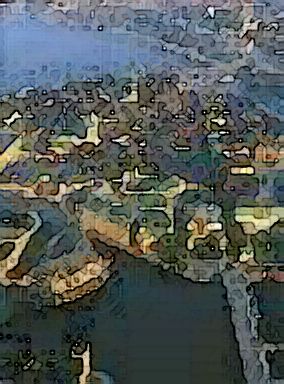




page updated: 05 July 2005
|
 |
 |
 |
 |
 |
Gender Sensitive Governance in the Field of TransportDaniela Jauk, Unviersity of Graz (Austria) Cosima Pilz and Daniela Jauk started their research asking: "Are there gender differences within existing participation methods in the field of transport in Austria?" and "How would a innovative particpation tool look like which is able to attract and invite especially women?" Exploratory research showed that not only Austria lacks a tradition and practise in citizen's participation generally but one can also find enormous gender gaps in the professional sphere of planning questions and transport politics (e.g. 96 of the participants of planning committees concerned with the current long-term regional transport concepts in Austria are male). Similar findings are reported by project partners from Italy, Great Britain and Germany. What already has been theoretizised among (feminist) scholars is that the gendered division of labour connected with differences in the availability of time and (financial) resources evoke different quality and quantity of female mobility. However, this knowledge actually influences the malestream planning context only marginally and was described by an interviewed official as "orchid theme ". Further, women are entitled to be "not interested" in tranport and public space; that is, as we can assume after 20 expert interviews done and analyzed, definitely not the case. Participation of women is rather a question of knowledge about female lifestyles, the use of adequate methods and the abandonment of an exclusive technical oriented discourse. As we were looking for "best practise participation technologies" also in other European countries, we developed innovative activating research instruments, which are:
The main activity will take place from February to May 2005, whereby the cooperative workshop is also meant to be a presentation and sustainability platform for the perspectives and demands of the women engaged in the project and the results of the study. The study shall contribute to local empowerment in the sense of initiating a discourse which focuses the explicite invitation of women in planning processes, the awareness of different life and mobility conditions and (gender)democratic, transparent decision structures. Abstract available HERE as a137kb pdf file |
The Internet in Daily Tasks: Forms of Use in Companies in Ponta Grossa (Brazil)Regina Pagani, Luiz Alberto Pilatti and Luciano Scandelari, Centro Federal de Educação Tecnológica do Paraná (Brazil) The objective of this paper is to verify how the use of the Internet occurs in nineteen companies in Ponta Grossa city, Parana, Brazil, making a comparison between the positive and negative aspects as for the daily use of the net in those companies. An exploratory research of qualitative nature was accomplished, having as instrument a questionnaire with closed and open questions. The data collecting was accomplished by means of telephone contacts with the person in chief of Computer Science, CPD and Information Technology departments of those companies. The companies act in the following activity branches: five of higher education, four of transportation, six multinational and four national big companies. The analysis of the results displays that the Internet is a tool of daily and indispensable use in the researched companies. On the other hand, the inadequate or improper use of the net can generate problems, so much to the companies as for the employees that use the Internet. It is concluded that companies cannot operate without the Internet, though this tool has to be wisely used and supervised in all the companies. Key words: Internet, Information Technology, Brazilian Companies Abstract available HERE as a139kb pdf file |
The Role of Communication Networks in the Practice of Space: The Heritage TourismSara Monaci, University of Turin (Italy) Communication networks are reshaping concepts of time and space: a new social theory, grounded on the model of network, replaces the notion of space of places with the one of space of fluxes (Castells 1996). According to Castells our contemporary megalopolis are growing by the influence of communication fluxes while a new architecture of fluxes is gradually reshaping forms and functions of public spaces and institutional places: city airports, stations and recent museums, like Koolhas' Lille Grand Palais and O'Gehry's Guggenheim in Bilbao, represent some examples of this new direction. (Mitchell 1995,1999; Castells 1996, 2004). Architectures of fluxes are gaining an increasing symbolic value due to their role as tourist attractions and related to the new forms of social practice and communication they can fulfill. In this paper I will investigate the idea of museum as space of fluxes and I will focus on three issues related to tourism practice: - Virtualization of space. Internet contributes to replace physical movement to museum with virtual experience through web sites and digital reproductions on DVD, CD-Rom or even Playstations. Virtual museums and portals for tourism give people tools for planning trips and visits according to individual needs and desires. Booking hotels, flights, museum tickets on the web allow individuals to arrange their own trip. Ubiquitous access to information and customized services on line represent opportunities to enhance the flexibility and the multiplicity; they give postmodern tourism new means of expanding and diversifying tourist experiences (Feifer, 1985). - Delocalization. Wireless networks and mobile devices have made the access to museums contents ubiquitous and literally on the move. Tourists can access virtual museums through the display of a PDA (Personal Digital Assistant) while they're at the airport or when they're in the museum: tourists can get a virtual visit while they're sipping a coke in a restaurant or they may decide to give it up seeing on the web that the exhibition they're interested in is over. Due to wireless networks, virtual space is no more linked to a physical location: it becomes a flux of communication and information integrated to the physical space, accessible wherever and whenever. Wireless networks allow a constant negotiation and reconfiguring of tourist objectives and paths. Tourists routes could be always reshaped according to information access: they could be the result of a mix of possibilities and connections among individuals and communication networks (Geser, 2004). - Colonization of the institutional setting of museum by private communication. Wireless devices (cell phone, smart phone, PDA) allow tourists to be always on: mentally connected with a network of friends and colleagues, but physically thousands of miles away. Practices of space supported by wireless devices reveal, on one hand, an increasing sense of detachment with the museum setting (Monaci, 2003) but, on the other hand, mobiles are perceived as invaluable devices for social interactions. Tourists strolling in museums with a cell phone or a smart phone can either perform private communications, either use the device to search for information related to the museum and exchange opinions with distant others or with people around. Many museums in Europe (Proctor, Tellis 2003) have already realized mobile applications aimed to support objects interpretation and communication exchanges among visitors. The sometimes intrusive presence of wireless devices is turning the institutional setting of a museum in a space of fluxes: a place where traditional tourist activities (guided tours, interpreting and sharing information) could be combined and enhanced by practices of spaces mediated by communication networks. References: Castells M., The rise of network society, Vol
I, Cambridge, M.; Oxford : Blackwell, 1996. Abstract available HERE as a 153kb pdf file |
Work Related Travel, Gender and Family ObligationsPer Gustafson, Uppsala University (Sweden) This paper uses national travel surveys from Sweden to examine the relationship between family situation, gender and work-related overnight travel. The results indicate that family obligations have an impact on travel activity, but that women and men differ in this respect. Cohabiting men travel more than men living alone, whereas there is no such effect among women. Having small children reduces the travel activity of women, whereas there is no consistent such effect among men. However, regardless of family situation men travel considerably more than women, and this largely reflects women's and men's different positions in working life. It is therefore argued that the relationship between work-related travel and family obligations involves both individual adaptation and structural factors, such as a gender-segregated labour market and 'gender-typing' of travel as a predominantly male activity, all of which reflect traditional gender and family role expectations Abstract available HERE as a 133kb pdf file Full text can be obtained from the author per.gustafson@ibf.uu.se |
page last updated: 01 July 2005
This page is maintained by members of the Odyssey Group
|
Stephen Little |
& |
Len Holmes, Director, |
 |
 |
 |
 |
 |